Molly’s Den is the name of a company that runs vast Vintage Antiques emporia in Hampshire and Dorset. We chose to visit the one in New Milton this morning. It offers several hours entertainment and the opportunity to pick up interesting bargains. There is a tea room, a very large play area, including an old bus, for children to amuse themselves for hours. The refreshments and the children’s facility provide welcome respite from wandering up and down the aisles examining the fascinating wares on display in units varying in size from a cabinet to a twelve foot square room-sized cubicle.
Elizabeth pointed out a ‘monstrosity‘, the family term for which is explained in my post of  that title. In fact the Molly’s Den one is far more tasteful than the telephone table described in that story.
that title. In fact the Molly’s Den one is far more tasteful than the telephone table described in that story.
 An unexpected embellishment to a desk caused me to look up to the ceiling in search of an open skylight. There wasn’t one.
An unexpected embellishment to a desk caused me to look up to the ceiling in search of an open skylight. There wasn’t one.
As always, exploring outlets for items which for some are history and for me reminiscent of my own lifetime, I was taken back to childhood by some exhibits. The several copies of the Dandy and Beano on offer dated mostly from the 1990s. We enjoyed them at home in the 1940s and ’50s, but we had to wait for Mum to read them first. In my photograph can be seen two painter’s footprints and Elizabeth and my sandalled toes. That seemed quite a happy coincidence.
The several copies of the Dandy and Beano on offer dated mostly from the 1990s. We enjoyed them at home in the 1940s and ’50s, but we had to wait for Mum to read them first. In my photograph can be seen two painter’s footprints and Elizabeth and my sandalled toes. That seemed quite a happy coincidence.
I have already featured the practical use Mum made of dressmaking patterns.  Today I noticed a rack of possible covers which were guaranteed to be contemporary with the tissue paper we sat and contemplated in our early years.
Today I noticed a rack of possible covers which were guaranteed to be contemporary with the tissue paper we sat and contemplated in our early years.

There was plenty of opportunity for Elizabeth and me to appear in a reflective mood. I even managed a selfie.
I bought an apparently unused 6 foot by 4 foot pure wool rug with hand-knotted fringes for the incredible price of £18. Jackie capped it with nine Victorian etched glasses for half that price.
For some reason Jackie and Elizabeth were amused at my efforts at photographing the glasses. I was oblivious of this as I concentrated on the subjects and got my lady to hold up a towel in an effort to reduce glare from the window. That particular device was soon abandoned because it produced a coloration that suggested that the receptacles already contained wine.
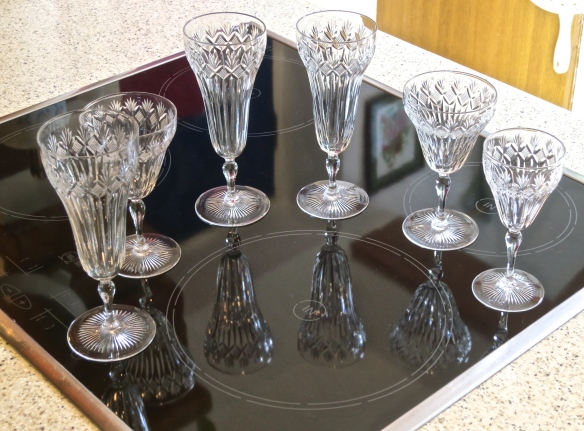
Reminiscing about our respective childhoods over lunch led to discussion of those rare trips to the seaside. Jackie’s grandfather, a motor factor, always had a car; but when Elizabeth was very small our Dad didn’t, and we relied on those of uncles. I have entirely forgotten one of our outings, but my younger sister has not. She was too young to remember the venue, but the story, from about 1959, has stood the test of time. Apparently Dad, Chris and I had sneaked a small suitcase onto the beach, unbeknown to our little sister. When we got home she was presented with the container. When she opened it, there before her very eyes was a heap of sand and shells enclosed in a secure space. She had her very own ‘seaside’ with which to play in her London garden.
This afternoon Jackie drove us to Woodgreen near Fordingbridge where nineteen artists feature in Hampshire Open Studios. First stop for us was to Pete and Nicky Gilbert’s idyllically sited beautifully restored home where Pete showed his paintings along with work by Hugh Lohan, Frances Barker, and Yukari. All the paintings, pastel portraits, photographs, jewellery, and woodwork were impressive. Pete’s landscapes and his life’s journey were truly inspirational. Further information can be found on his website at www.pgilbert.me.uk
Elizabeth bought a print of one of Pete’s pieces, more of which are seen behind him in my photograph. She then dashed back for a chopping board.
We proceeded to Coach House Studio to see the work of Andrea Finn, Dawn Gear, Sarah Orchard, Sarah Waters and Wendy de Salis. These included jewellery, ceramics, sculpture, textiles, and paintings.I had a long conversation with Sarah Waters who is developing the creation of fabrics using the combination of yeast and bacteria in a glucose solution. 

 This produces a mat of cellulose fibres which form a vegetable ‘leather’. One table displayed Kombucha, the process; and another the product, more of which was suspended against the light. Sarah’s website is www.sarahwaterstextiles.com
This produces a mat of cellulose fibres which form a vegetable ‘leather’. One table displayed Kombucha, the process; and another the product, more of which was suspended against the light. Sarah’s website is www.sarahwaterstextiles.com
We bought three of Wendy de Salis’s ceramic birds to hang in our trees.  The sun, playing in the smokebush tree in Wendy’s garden, seemed to know it was part of the group of artists.
The sun, playing in the smokebush tree in Wendy’s garden, seemed to know it was part of the group of artists.
Hordle Chinese Take Away provided their usual splendid meal for our dinner. Elizabeth and I drank more of the Cuvee St Jaine. Drank open, and enjoyed, the dry white version.
Tag: shells
Spaghetti, And How To Eat It
There is quite a lot of rubble and other kinds of rubbish scattered about the garden.
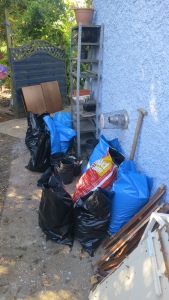
We have been bagging it up for transfer to the Efford Recycling Centre which is our municipal dump. We thought two trips would be sufficient. There was, however, a queue to enter the site, probably because it was Monday morning and people had been clearing their homes and gardens at the weekend. We will wait a day or two for the next visit. We have only visited this location once before, but have been, as we were today, impressed with the friendliness and dedication of the staff. This day it was ‘Andy Manager’, as his T-shirt informed us, who advised us where to put what. This is clearly not just any old job for these men. Andy demonstrated a passion for his work, as he explained what would happen to various items and why which material went where. There is apparently only one landfill site left locally at Ringwood and this would cause problems, ‘not in our lifetime, but for our children’s children’.
Naturally, Jackie just had to buy some more plant pots from the Sales Area.
Twenty four hours after I had been told by yesterday’s BT adviser that the problem with e-mail access would be resolved in that time, it wasn’t. I rang again. This time the robot on the other end of the line informed me that BT were well aware of the problem, so I didn’t need to wait in a queue to report it. Engineers were working to resolve it and the company was very sorry for the inconvenience caused.
We have a saying, relating to constant change, which is: ‘If it ain’t broke, don’t fix it’. (This, translated into correct English, would read: ‘if it isn’t broken, don’t fix it’.) I would say to BT: ‘I wish you hadn’t changed it. Now it is broke, do fix it’.

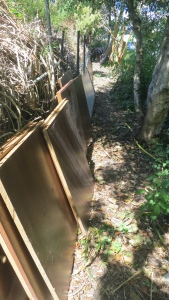

This afternoon we continued clearing up rubbish, and in the process found a pit of broken tiles that we began to bag up. Whilst I was away, Jackie had transported most of the remaining IKEA wardrobe sections to the path adjoining the deserted garden that I had cleared a couple of months ago. This is to reinforce the non-existent boundary. We carried the rest across, and I began to prop them in place, at the same time lopping stubbornly invasive brambles.
Along with liberal bits of plastic and chunks of polystyrene, we have been somewhat mystified by the number of sea and escargot shells scattered among the soil in the garden. Jackie thought they should have been crushed but wasn’t sure what the purpose was. We also wondered whether our predecessors had a penchant for seafood.
I went on line and sought the answer, which was provided by doityourself.com. These shells, when crushed, are regarded as a useful mulch. The website advises that most seafood restaurants are happy to provide them for punters. ‘The best time’, we are advised, ‘to add this organic mulch is later spring or early summer when the soil is warm. As the shells decay they ‘will provide the soil (with) the minerals and calcium’ it needs. You will ‘save money in the long run on soil additives and amendments’.
‘Yes. Same as getting a bit of lime’, our head gardener sniffed scathingly. She thought, especially in their uncrushed state, that these shells might take some time to do their job.
Six years ago, when I was going through my hip replacement period, my GP, Dr O’Connor, bless her, told me I would never have a blood pressure problem. I do hope she is right, for it was severely tested this afternoon. With BT still not having resolved the e-mail problem, I received a call on my mobile phone from O2 who wanted to check that I had the most suitable contract for my needs. We got as far as the initial identification stage. When asked for the first line of my address and the postcode, I was informed that the first line was correct, but the postcode wasn’t. Believing that I was the best judge of where I lived, I terminated the conversation, and checked the address O2 had put on my last bill. The first line was correct, as were most of the others, but the postcode was that of our previous abode. Goodness knows how it reached me. Possibly full marks to the Post Office. I prevailed upon the unfortunate young woman who answered my call to change the company’s records.
Later, I ambled down to the Spar shop and back, to buy matches to light a bonfire soon afterwards.
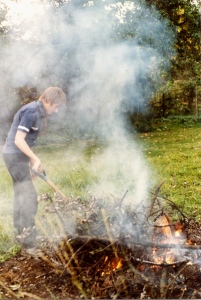
Matthew is quite good at bonfires. In September 1983, he helped Jessica’s, sadly late, cousin Anthony with one in Aunt Elspeth’s garden in Rugby. I haven’t been able to locate the negative of this photograph, but the print, after more than thirty years, is still serviceable.
At 7.49 this evening I received a text from BT apologising for the e-mail problems, saying they were trying hard to fix it, and pointing me to a web-site for updates. Well, I suppose that’s something.
For dinner we enjoyed Jackie’s scrumptious spaghetti arrabiata. I thought I would try the other half of a bottle of Via di Cavallo chianti 2013 that I had opened a couple of days before my recent French trip. I immediately decided it would be more suitable in a sausage casserole, and opened another. And drank some. Jackie drank Hoegaarden.
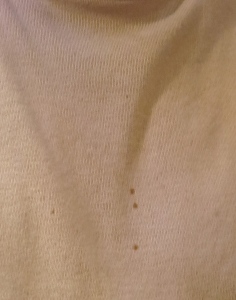
During dinner, I received a lesson in the consumption of spaghetti. Jackie has patiently tolerated my efforts over the years, but today’s performance was too much for her. She guided me in the correct procedure. You take a spoon in your right hand (always assuming you are not left-handed), and a fork in your left. What you don’t do is twist as much spaghetti as possible around your fork, simply using the spoon as a guide, and try to suck up the slithering pasta before it slips back onto your plate. You don’t bite off the last bits and let them drop into the sauce, spotting your T-shirt with a tomato based preparation. What you do do, is take just two or three strands, twine them round your fork, and withdraw the tines, letting the coil perch on your spoon, from which you then consume it.